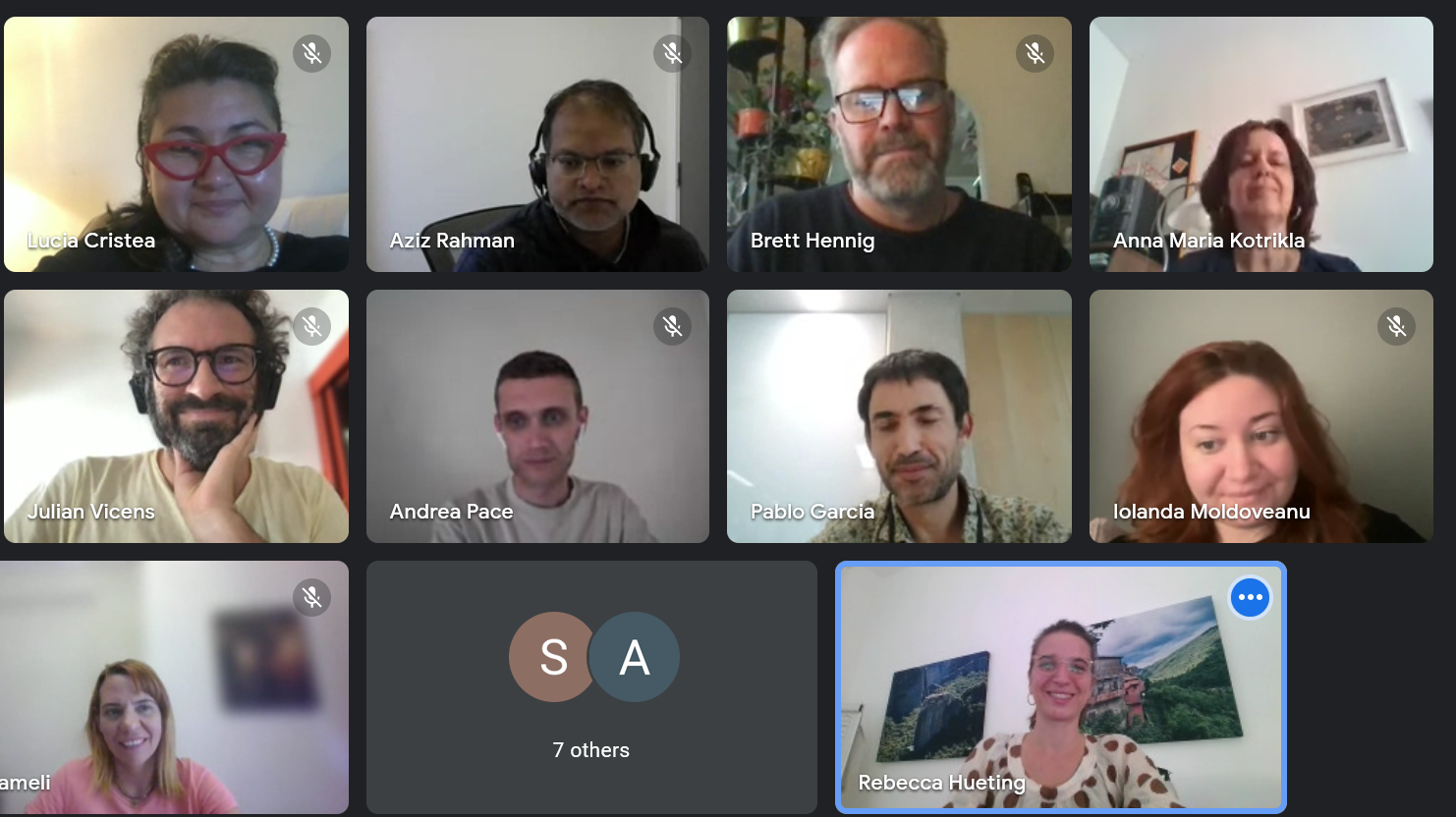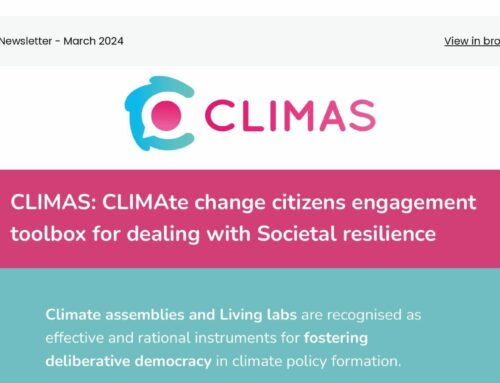The CLIMAS project is glad to announce that the first External Advisory Board (EAB) meeting report is finally ready. The EAB meeting took place online on October the 9th, 2023 organised by Deep Blue with the support of all CLIMAS partners, especially cambiaMO and Vilnius Tech coordination team.
The meeting main goal was that of sharing our preliminary insights on stakeholder needs’ and expectations, to develop a set of tools which could be tangibly and positively impacting Climate Assemblies. The CLIMAS Toolbox will soon enter its testing phase and this first expert feedback session was the ideal opportunity to collect feedback and better steer upcoming activities. Thanks to a matchmaking session organised by EIP, our partner responsible for the engagement of local institutions across different EU regions, EAB members and partners could agree on planning bilateral meetings and document review sessions.
A diversified group of eight experts joined online, with work package leaders moderating discussions and Q&A sessions.
Overview of participants’ expertise
1 – Expert on citizen participation and researcher from the CSIS IPP Instituto políticas y bienes públicos
2 – Professor of Earth Sciences, Oceanography and Climate Change at the HCMR – Hellenic Centre for Marine Research
3 – Co-founder and director of the Sortition Foundation promoting deliberative democracy in UK, USA and Australia
4 – Professor and expert of Citizen Science at the AEGEAN University – School of the Environment Department of Marine Sciences
5 – Expert in the field of civic engagement in Latin America, Turkey and Spain, State University of New York
6 – Climate Assembly pratictioner and representative from Visionary.org
7 – Representative from the JRC makerspace and expert in deliberative democracy
8 – Founding chair from the KNOCA Network and professor of Politics at the Westminster University
Meeting report
- 14:30 | Tour de table DBL
The first part of the meeting was dedicated to a full “tour de table”, an essential moment to introduce project partners to External Advisory Board members and allow them presenting their role, expertise and interest in the project.
- 14:40 | Speed-intro + Q&A VILNIUS TECH
Soon after, our project coordinator Prof. Aelita Skaržauskienė shortly summarized the project challenge, ambition and expected results, quickly going over the main contents of the project slide deck, shared with all EAB members prior to the meeting.
- 14:45 | WP 2,3,4 quick overview
The core part of the meeting was dedicated to collect opinions and remarks from EAB members on the methodologies adopted for the identification of barriers (WP2), co-creation of tools (WP3) and on the testing and evaluation methodologies for the CLIMAS Toolbox, offering a space for open discussions in the form of Questions and Answers sessions. The work package leaders moderated discussions at the end of their short presentations:
-
- Elisabeth Frankus from IFOK for Work Package 2
- Aziz Rahman from Technovative solutions for Work Package 3
- Maria Alonso Raposo from cambiaMO for Work Package 4
WP2 – Identifying barriers and facilitators of citizen climate participation using previous Climate assembly cases
The initial focus explained how the CLIMAS project kicked-off by undergoing an in-depth analysis of existing models (OECD, KNOCA) and identified challenges and opportunities through grey and scientific literature review, review of case studies and past citizens’ assemblies within Europe. The criteria adopted for the analysis were: inclusion, framing, information collection methods, follow-up processed and use of digital platforms. The preliminary results will be available by the end of this year. Open questions included:
- Q – In case studies and literature, there is often a focus on a technology as a digital platform. But we can also consider technologies as social and methodological interventions to improve the climate assembly process. How do you perceive the distinction between digital versus social technologies in Climate Assemblies?
- Q – In T2.2 workshops prioritisation and consensus-building was used to identify barriers and drivers in CA. What do you think about these approaches in this context?
Here the answer from one of our EAB members:
A – EAB member – I love the idea of integrating citizen science into Citizen Assemblies. Particularly getting members out on the streets to collect local data (and hence experience) that they can reflect on collectively. I am aware about an experience at Southampton CA University, where they were talking about getting members to monitor traffic movements outside schools in between weekends – the assembly is on local transport and climate. Not sure they followed this through, but I thought it could be worth mentioning.
WP3 – Co-creating the Climate change citizens engagements Toolbox for regional and local entities
During this session involved partners presented the progress and next steps in CLIMAS tools’ development and the the work package leader TVS explained the overall concept diagram of the CLIMAS Toolbox, including its relationship with other tasks where collection of data, needs and requirements are foreseen.
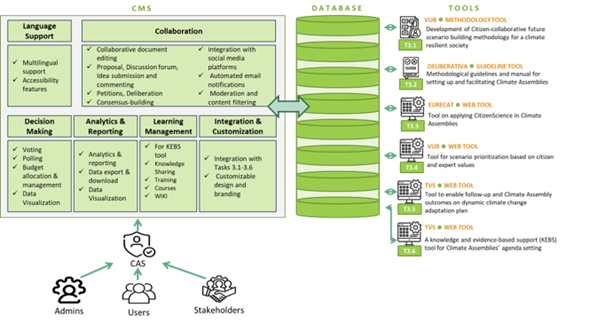
copyright @CLIMAS 2023
WP4 – Testing the Toolbox in real deliberative Climate Assemblies (CA) and Living Labs (LL)
Finally, cambiaMO presented the testing and evaluation approach of the CLIMAS project. In particular the mix of qualitative and quantitative methods to collect feedback and the iterative nature of testing phases was described. Advisory board members. Open questions addressed the following:
-
- Q – Would you have any suggestion regarding possible testing approaches to evaluate the tools?
- Q – What would be your recommendations for the definition and planning of tests?
A- EAB member – depends on what you are testing for, within the community of facilitators who prioritise equality, others prioritise agency. If the criteria is quality, the first applies, if it’s the second, hands-on sessions are better. There are so many ways people approach assemblies and if you go there thinking that there is one way to do it, but rather explain the benefits of the different types of facilitation and help participants choose the most appropriate. I am afraid a Toolbox could end up defining what is the right facilitation style or the most successful, while it should instead leave space for creativity and offer more options.
A – Partner – actually, the CLIMAS project is going more towards “checklists”, as to ensure that instead of saying in advance which way is the best way to facilitate a CA, we rather offer guidance to check needs and propose different options.
One EAB member asked if the selection methodology would be shared with EAB members and a partner confirmed that it will be included in the Guidelines that will be delivered by the project at the end of this year.
- 15:00 | Interactive activity in breaking rooms
This session had the objective of offering a more informal environment for EAB members and partners to exchange views in smaller groups, with a focus on diversity, inclusivity and equity issues. The room 1, led by Carmen Nieto from Deliberativa, explored the existing barriers to inclusion and how to address them, especially in the sortition and recruitment phase. In room 2, led by Floridea di Ciommo and Maria Alonso Raposo from cambiaMO, the focus was more on inclusive facilitation methods to be adopted before, during and after a Climate Assemblies
Room 1 – SORTITION: HOW TO ENSURE INCLUSIVITY IN CLIMATE ASSEMBLIES? [Moderation by Carmen Nieto, Deliberativa]
Guiding questions:
- What are the main obstacles to the inclusion of people living in vulnerable conditions in Citizens’ Assemblies? In your experience, how can they be addressed?
- Can you give us some examples on how to efficiently involve citizens from marginalised communities?
The group in Room 1 focused on sortition methods to increase inclusivity and on how to reduce barriers to increase participation and inclusion. Some of the policies and decisions that were considered relevant to this issue and that emerged from the debate were as follows:
- The database selected for recruitment.
- Strategies for reaching lower socio-economic groups.
- On the age of participants and how to involve younger people.
- Inclusion of ethnicity variable in stratification.
- Strategies to keep people in the process.
- Q – what methods are currently being used to help reduce barriers to participation?
A – EAB member – we shall lower the barriers to increase registration rates: pay them for their time, give them enough time to register, overrepresent certain groups that are usually excluded. Making questions super relevant to the people and avoid jargons. We can have dedicated discussions on it.
A – different EAB member – my suggestion would be that of limiting slides and presentations, which are sometimes of course needed but interaction and consideration of different learning styles is paramount.
Room 2 – FACILITATION: HOW TO ENSURE INCLUSIVITY IN CLIMATE ASSEMBLIES? [Moderation by Floridea di Ciommo, cambiaMO]
Guiding questions:
- What are the key aspects to keep in consideration before, during and after a Climate Assembly to achieve inclusivity? Can you provide examples?
The room 2 focused on the organisational, communication and implementation aspects of facilitation that shall be kept into consideration before, during and after a Climate Assembly, to ensure the highest inclusivity to those living in vulnerable conditions or are experiencing marginalisation issues. Avoiding slides was suggested also in this room, starting with ourselves in the context of CLIMAS, Climate Assemblies and Living Slides.
The discussion was supported by a digital padlet where all participants could write down their experiences and opinions[1]. The key takeaways are reported here and in the image below:
Before
What shall be done in order to reassure participants in terms of inclusivity of Citizen Assemblies facilitation and provision of information?
- Make the goals of the assembly clear to all.
- Develop accessible tools and materials to use during the assembly.
- Content should be available in the language of the participants.
- Information provided to participants should be done using different media (e.g., text, infographics, videos), following a progressive disclosure (i.e., with growing levels of complexity).
- Ensure that there are tools electronically available but also available on paper for people who may not be tech savvy.
- Spend much time to train the facilitators! They need to understand and internalize their role and their tasks, but ‘soft factors’, such as how to make citizens feel welcome and the language they use.
During
Inclusion vs agency: how much should facilitation focus on ensuring equality of voice (tighter table facilitation) or on enabling assembly members to follow their interests and organise themselves?
- Inclusion vs agency: The second approach may be more creative.
- Knowledge curation: make sure variety of materials that are sensitive to different learning styles. Death by powerpoint vs more embodied learning. Not everyone can sit at a table for hours!
- Example: use inclusive language that acknowledges diversity and conveys respect to all people
After
Post-assembly support: what does inclusivity mean once the assembly has produced its recommendations? What ongoing support do we owe members? Tends to be most politically confident that want to continue working collectively – how do we respond to the changes in patterns of diversity?
- Outcomes format: explore different media for the presentation of the outcomes.
- Example: share outcomes from the assembly sessions with the participants, including how their contributions are going to be used.
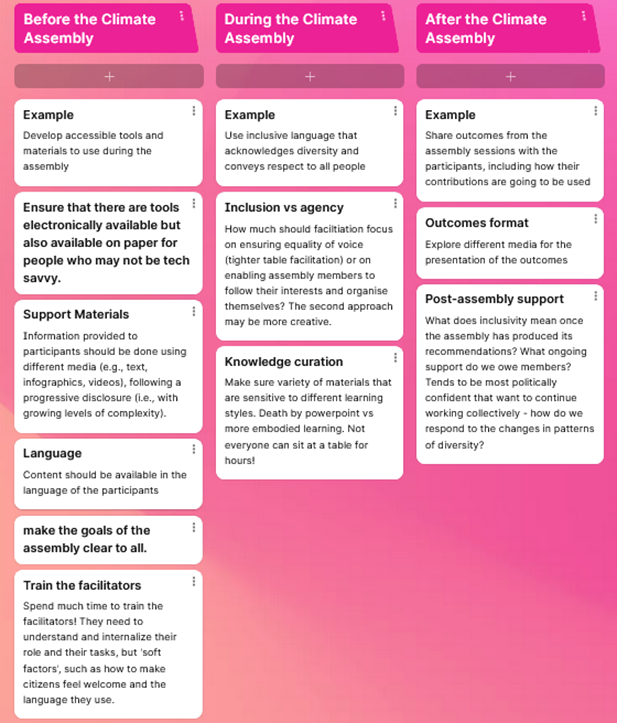
- copyright @CLIMAS 2023
[1] https://padlet.com/tools37/climas-1st-external-advisory-board-workshop-m8vopbgs9qk4wxhz
- 15:30 | MATCHMAKING exercise EIP
This session led by Iolanda Moldoveanu and Lucia Cristea from EIP focused on presenting EAB members’ our outreach strategy to get in contact with as many European Regions as possible and to ask for support in achieving our target of 150 regions contacted.Moreover, members could declare their level of interest in specific research topics and work packages.
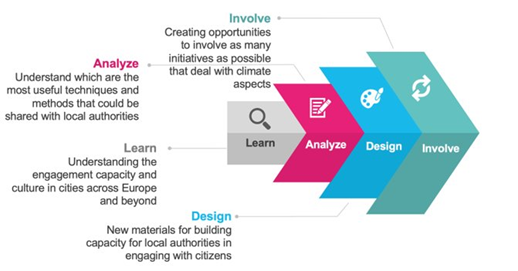
copyright @CLIMAS 2023
- 15:45 | Wrap-up and final remarks, Deep Blue
The last session gave EAB members the floor to share their final observations related to the project advancement and preliminary results as well as to ask questions. One EAB member underlined the added value of creative activities during Climate Assemblies. While commenting the facilitation guidelines documents (previuosly shared by Deliberativa via email ndr.) he also underlined the value of adopting different facilitation styles depending on context: rather than telling what to do to participants, decide with them what and how they would like to proceed, to achieve deliberation in a given time. A partner mentioned that guidance can be pursued through checklists, to ensure to include opinion and needs of different people and utilise a balanced mix of different methods to run the assemblies.
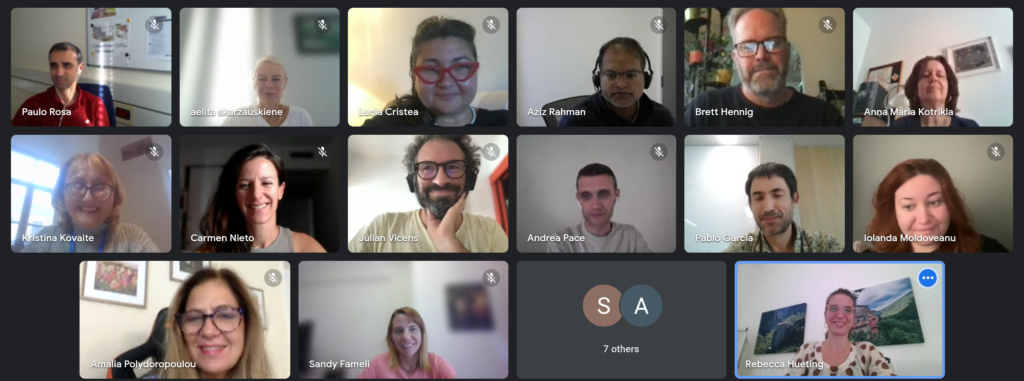
CLIMAS Advisory Board group – copyright @CLIMAS 2023
Follow us on LinkedIn, and Twitter, or subscribe to the newsletter to stay updated with the latest activities.
